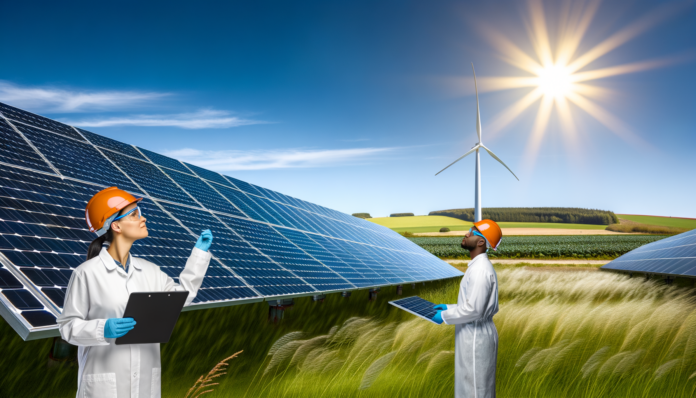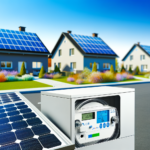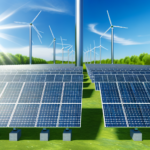Introduction
Overview of Solar Power
Solar power, derived from the sun’s energy, has emerged as a cornerstone of the renewable energy sector. Harnessing sunlight through photovoltaic (PV) cells, solar power systems convert solar radiation into electricity, providing a clean and sustainable energy source. Over the past few decades, solar technology has seen remarkable advancements, making it more efficient, affordable, and accessible. From residential rooftops to large-scale solar farms, the adoption of solar power is accelerating globally, driven by the urgent need to reduce carbon emissions and combat climate change.
Importance of Innovation in Solar Technology
Innovation in solar technology is crucial for several reasons. Firstly, it enhances the efficiency of solar panels, allowing them to convert more sunlight into electricity. This not only maximizes energy output but also reduces the space required for installations, making solar power more viable for urban environments. Secondly, advancements in materials and manufacturing processes can significantly lower the cost of solar panels, making renewable energy more affordable for a broader audience. Thirdly, innovative solar solutions, such as portable solar devices and building-integrated photovoltaics (BIPV), expand the applications of solar power, integrating it seamlessly into our daily lives and infrastructure. Lastly, breakthroughs in energy storage technologies ensure that solar power can be reliably used even when the sun isn’t shining, addressing one of the major limitations of solar energy.
Purpose of the Article
The purpose of this article is to explore the latest innovations in solar power technology that are revolutionizing the renewable energy landscape. By delving into advancements in solar panel efficiency, portable solar solutions, integration of solar power in everyday products, and innovative storage solutions, we aim to provide a comprehensive overview of the cutting-edge developments shaping the future of solar energy. Additionally, we will examine emerging trends such as building-integrated photovoltaics, solar windows, and floating solar farms, which promise to further enhance the versatility and adoption of solar power. Through this exploration, we hope to highlight the potential of these innovations to drive the widespread adoption of solar energy, contributing to a more sustainable and resilient energy future.
Advancements in Solar Panel Efficiency
High-Efficiency Photovoltaic Cells
In recent decades, solar panel efficiency has seen remarkable advancements. Early solar panels had a conversion efficiency of around 10%, but today, thanks to continuous research and technological breakthroughs, modern panels achieve efficiencies exceeding 20% and even 25%. This means that solar photovoltaic (PV) systems can convert nearly a quarter of the sunlight they receive into clean, renewable energy. Higher efficiencies make solar energy a more viable and attractive option for homeowners, businesses, and entire cities, reducing the space required for solar panels and allowing for greater electricity production from the same amount of sunlight.
Bifacial Solar Panels
Bifacial solar panels provide a unique advantage in solar energy generation by capturing sunlight from both the front and back of the module. This innovative design allows them to utilize reflected sunlight from various surfaces, such as the ground, water, or nearby structures, resulting in increased electricity yield. Recent advancements in bifacial solar panel technology have contributed to their growing market share in the renewable energy sector. The global bifacial solar panel market has witnessed notable growth due to factors such as increased demand for clean energy, improved efficiency, cost reduction, and environmental benefits.
**Pros of Bifacial Solar Panels:**
– **Higher Energy Yield:** Capture sunlight from both sides, resulting in increased energy production.
– **Durability and Longevity:** Built to withstand environmental conditions.
– **Better Performance in Diffuse Light:** Generate energy from diffuse or reflected light, suitable for cloudy or low-light conditions.
– **Versatile Applications:** Can be used in various applications, including rooftops, carports, and floating solar farms.
**Cons of Bifacial Solar Panels:**
– **Higher Cost:** Typically more expensive than traditional panels.
– **Specialized Mounting:** Require a different mounting system that allows light to reach both sides, increasing installation complexity and cost.
– **Potential Dust and Dirt Accumulation:** The backside is exposed, requiring more frequent cleaning and maintenance.
Perovskite Solar Cells
Perovskite solar cells have emerged as a promising solution due to their low production costs and high efficiency. Perovskites are a semiconductor material known for their crystal structure resembling perovskite minerals. They can effectively convert sunlight into electricity due to their ability to absorb a wide range of wavelengths, including visible and near-infrared spectra. Their low-cost and relatively simple manufacturing process, along with ongoing research to improve their solar efficiency and stability, positions them as a potential game-changer in the renewable energy industry alongside traditional silicon-based semiconductors.
**Recent Announcements in Perovskite Solar Cell Research:**
– **LONGi’s Record-Breaking Efficiency:** In November 2023, LONGi achieved an efficiency of 26.81% with its tandem solar cells.
– **University of Colorado Boulder’s Manufacturing Innovation:** Scientists unveiled a new method for manufacturing perovskite cells, potentially critical for commercializing next-generation solar technology.
Despite the potential benefits, challenges remain for the widespread commercial use of perovskite solar cells. Researchers are actively working to improve the stability and scalability of these cells. By resolving these issues, perovskite solar cells could become a cost-effective and efficient alternative to traditional silicon-based solar panels, offering a significant boost to the renewable energy industry.
Portable Solar Solutions
Foldable Solar Panels
Foldable solar panels represent a significant leap in solar technology, offering unparalleled convenience and portability. These panels are designed to be lightweight and compact, making them ideal for outdoor enthusiasts, travelers, and emergency preparedness. The ability to fold and unfold these panels allows users to easily transport and deploy them in various settings, from camping trips to remote work sites.
One of the key advantages of foldable solar panels is their versatility. They can be used to charge a wide range of devices, including smartphones, tablets, laptops, and even small appliances. This makes them an excellent choice for those who need a reliable power source while off the grid. Additionally, many foldable solar panels come equipped with multiple USB ports and DC outputs, providing flexibility in how the generated power is used.
The efficiency of foldable solar panels has also improved significantly in recent years. Advances in photovoltaic cell technology have led to higher energy conversion rates, ensuring that users can generate more power from a smaller surface area. This increased efficiency, combined with the panels’ portability, makes them a practical solution for sustainable energy on the go.
Solar-Powered Backpacks
Solar-powered backpacks are another innovative solution that integrates solar technology into everyday items. These backpacks are equipped with built-in solar panels that can charge electronic devices while on the move. Ideal for hikers, students, and professionals, solar-powered backpacks offer a convenient way to keep gadgets charged without relying on traditional power sources.
The design of solar-powered backpacks typically includes a durable, weather-resistant exterior to protect the solar panels and internal components. Inside, the backpacks feature compartments and pockets designed to hold and organize various devices and accessories. Some models even include built-in batteries to store excess energy, allowing users to charge their devices even when the sun isn’t shining.
The practicality of solar-powered backpacks extends beyond personal use. They are increasingly being adopted in humanitarian efforts, providing a reliable power source in disaster-stricken or remote areas where electricity is scarce. By harnessing the power of the sun, these backpacks can help bridge the energy gap and improve the quality of life for people in need.
Portable Solar Generators
Portable solar generators are a robust solution for those who require a more substantial and reliable power source. These generators combine solar panels with high-capacity batteries, allowing users to generate and store significant amounts of energy. Portable solar generators are ideal for a variety of applications, including camping, RVing, and emergency backup power for homes.
One of the main benefits of portable solar generators is their ability to provide a clean and quiet alternative to traditional gas-powered generators. They produce no emissions and operate silently, making them an environmentally friendly and neighbor-friendly option. Additionally, the cost of solar generators has decreased over the years, making them more accessible to a broader audience.
Modern portable solar generators come with a range of features designed to enhance their usability. These include multiple AC and DC outlets, USB ports, and even wireless charging capabilities. Some models also offer advanced monitoring systems that allow users to track energy production and consumption in real-time, optimizing the use of stored power.
In conclusion, portable solar solutions like foldable solar panels, solar-powered backpacks, and portable solar generators are revolutionizing the way we harness and utilize solar energy. These innovations provide practical, sustainable, and versatile options for generating power on the go, making renewable energy more accessible and convenient for everyone.
Solar Integration in Everyday Products
Solar-Powered Lighting
Solar-powered lighting has become a popular and practical application of solar technology in everyday life. These lighting solutions harness the power of the sun to provide illumination without relying on traditional electricity sources. **Solar-powered lights** are commonly used in outdoor settings, such as gardens, pathways, and streetlights, where they offer several advantages:
- Energy Efficiency: Solar lights convert sunlight into electricity during the day and store it in batteries for use at night, reducing the need for grid electricity.
- Cost Savings: By eliminating the need for electrical wiring and reducing electricity bills, solar lighting can be a cost-effective solution for both residential and commercial properties.
- Environmental Benefits: Solar lighting reduces carbon emissions and reliance on fossil fuels, contributing to a greener environment.
- Easy Installation: Most solar lights are easy to install and require minimal maintenance, making them an attractive option for homeowners and businesses alike.
Innovations in solar lighting technology have led to the development of more efficient and durable products. For example, advancements in LED technology have improved the brightness and longevity of solar lights, while smart sensors and automation features allow for better energy management and user convenience.
Solar-Powered Chargers
Solar-powered chargers are another innovative application of solar technology, providing a convenient and eco-friendly way to charge electronic devices. These chargers come in various forms, including portable solar panels, solar power banks, and integrated solar chargers for specific devices. The benefits of solar-powered chargers include:
- Portability: Many solar chargers are designed to be lightweight and compact, making them ideal for outdoor activities, travel, and emergency situations.
- Renewable Energy Source: By using solar energy to charge devices, users can reduce their dependence on conventional electricity and lower their carbon footprint.
- Versatility: Solar chargers can be used to power a wide range of devices, including smartphones, tablets, cameras, and even laptops, depending on the charger’s capacity.
- Cost Savings: Over time, solar chargers can save money on electricity bills and reduce the need for disposable batteries.
Recent advancements in solar charger technology have focused on improving efficiency and charging speed. For instance, some modern solar chargers incorporate high-efficiency photovoltaic cells and advanced power management systems to maximize energy conversion and storage.
Solar-Powered Appliances
The integration of solar technology into household appliances is revolutionizing the way we use energy in our daily lives. Solar-powered appliances are designed to operate using solar energy, either directly or through stored solar power. Some common examples include:
- Solar Water Heaters: These systems use solar collectors to heat water, providing an energy-efficient alternative to traditional water heaters.
- Solar Refrigerators: Solar-powered refrigerators are particularly useful in off-grid and remote areas, where they can provide reliable cooling without the need for grid electricity.
- Solar Ovens: Solar ovens use reflective materials to concentrate sunlight and cook food, offering a sustainable cooking solution that requires no fuel.
- Solar Air Conditioners: These systems use solar energy to power air conditioning units, reducing electricity consumption and cooling costs.
The adoption of solar-powered appliances offers several benefits, including reduced energy costs, lower environmental impact, and increased energy independence. As technology continues to advance, we can expect to see even more innovative solar-powered appliances entering the market, further integrating renewable energy into our everyday lives.
Innovative Solar Storage Solutions
Next-Generation Solar Batteries
The evolution of solar energy storage has seen significant advancements, particularly with the development of next-generation solar batteries. Traditional lead-acid batteries, once the cornerstone of solar storage, have largely been replaced by more efficient and longer-lasting lithium-ion batteries. These batteries offer higher energy density, faster charging capabilities, and a longer lifespan, making them ideal for both residential and commercial solar energy systems.
However, the innovation doesn’t stop there. Flow batteries, which store energy in liquid electrolytes, are gaining traction for large-scale applications due to their scalability and durability. Another promising development is graphene-based batteries, known for their superior energy density and rapid charging capabilities. These batteries can significantly enhance the efficiency of solar energy systems, making them more reliable and cost-effective.
Moreover, the integration of Artificial Intelligence (AI) into solar storage systems is revolutionizing the industry. AI can manage storage systems more efficiently, optimize energy usage, and predict demand, ensuring a reliable supply of energy even during peak times. These advancements in solar battery technology are crucial for reducing our reliance on fossil fuels and promoting a more sustainable energy future.
Solar-Powered Water Heaters
Solar-powered water heaters are another innovative solution that leverages solar energy for everyday use. These systems use solar collectors to capture and convert sunlight into heat, which is then used to warm water for domestic or commercial use. Solar water heaters can significantly reduce energy bills and carbon footprints, making them an attractive option for eco-conscious consumers.
There are two main types of solar water heaters: active and passive systems. Active systems use pumps to circulate water or a heat-transfer fluid through the collectors, while passive systems rely on natural convection. Both types have their advantages, but active systems are generally more efficient and can provide hot water even on cloudy days.
The benefits of solar-powered water heaters extend beyond cost savings. They also reduce greenhouse gas emissions and decrease dependence on non-renewable energy sources. As technology advances, these systems are becoming more efficient and affordable, making them a viable option for a broader range of consumers.
Solar-Powered Refrigeration
Solar-powered refrigeration is another groundbreaking innovation that addresses the need for reliable and sustainable cooling solutions. These systems are particularly beneficial in remote or off-grid areas where access to electricity is limited. Solar refrigerators use photovoltaic panels to convert sunlight into electricity, which powers the refrigeration unit.
One of the key advantages of solar-powered refrigeration is its ability to provide consistent cooling without relying on the grid. This is especially important for preserving food and medical supplies in areas with unreliable electricity. Additionally, solar refrigerators can reduce energy costs and carbon emissions, contributing to a more sustainable future.
Recent advancements in solar refrigeration technology have focused on improving efficiency and storage capacity. For example, some systems now incorporate advanced battery storage to ensure continuous operation during nighttime or cloudy days. These innovations are making solar-powered refrigeration a practical and eco-friendly solution for a wide range of applications.
In summary, the latest innovations in solar storage solutions, including next-generation batteries, solar-powered water heaters, and solar-powered refrigeration, are transforming the way we harness and utilize solar energy. These advancements are not only enhancing the efficiency and reliability of solar power but also making it more accessible and sustainable for everyday use. As technology continues to evolve, we can expect even more groundbreaking developments in the field of solar energy storage.
Emerging Trends in Solar Technology
Building-Integrated Photovoltaics (BIPV)
Building-Integrated Photovoltaics (BIPV) represent a significant leap forward in the integration of solar technology into everyday structures. Unlike traditional solar panels that are mounted on rooftops or in open fields, BIPV systems are seamlessly incorporated into the building materials themselves, such as roofs, facades, and windows. This integration not only enhances the aesthetic appeal of buildings but also maximizes the use of available space for energy generation.
**Advantages of BIPV:**
– **Aesthetic Integration:** BIPV systems blend with the architectural design, maintaining the visual appeal of buildings.
– **Space Efficiency:** By integrating solar cells into building materials, BIPV makes use of surfaces that would otherwise be idle.
– **Energy Efficiency:** BIPV can contribute to the building’s energy needs directly, reducing reliance on external power sources.
**Challenges:**
– **Cost:** The initial installation cost of BIPV systems can be higher than traditional solar panels.
– **Complexity:** Integrating solar technology into building materials requires specialized design and installation expertise.
Despite these challenges, the potential for BIPV to transform urban landscapes into energy-generating hubs is immense. As technology advances and costs decrease, BIPV is expected to become a standard feature in modern architecture.
Solar Windows
Solar windows are an innovative extension of BIPV technology, designed to transform ordinary windows into energy-generating surfaces. These windows are embedded with transparent photovoltaic cells that capture sunlight and convert it into electricity without obstructing the view or reducing natural light.
**Key Benefits:**
– **Dual Functionality:** Solar windows provide the dual benefits of natural lighting and energy generation.
– **Aesthetic Appeal:** They maintain the transparency and appearance of regular windows, making them ideal for both residential and commercial buildings.
– **Energy Savings:** By generating electricity, solar windows can significantly reduce a building’s energy consumption and utility costs.
**Current Developments:**
– **Efficiency Improvements:** Researchers are continually working to improve the efficiency of solar windows, aiming to increase the amount of energy they can generate.
– **Material Advancements:** Innovations in materials, such as perovskites, are enhancing the performance and durability of solar windows.
Solar windows hold the promise of turning skyscrapers and residential buildings into vertical power plants, contributing to a more sustainable urban environment.
Floating Solar Farms
Floating solar farms, also known as floatovoltaics, are an emerging trend that involves installing solar panels on bodies of water such as lakes, reservoirs, and even oceans. This innovative approach addresses the land scarcity issue and offers several unique advantages.
**Advantages:**
– **Land Conservation:** Floating solar farms do not require large tracts of land, making them ideal for densely populated areas.
– **Increased Efficiency:** The cooling effect of water can enhance the efficiency of solar panels, leading to higher energy output.
– **Water Conservation:** By covering water bodies, floating solar farms can reduce evaporation, conserving valuable water resources.
**Challenges:**
– **Installation and Maintenance:** Installing and maintaining solar panels on water surfaces can be more complex and costly than land-based systems.
– **Environmental Impact:** The potential impact on aquatic ecosystems needs to be carefully assessed and managed.
**Global Adoption:**
Countries like Japan, China, and India are leading the way in the adoption of floating solar farms, recognizing their potential to contribute significantly to renewable energy targets. As technology advances and costs decrease, floating solar farms are expected to become a more common sight worldwide.
In conclusion, these emerging trends in solar technology—Building-Integrated Photovoltaics, Solar Windows, and Floating Solar Farms—are paving the way for a more integrated and efficient use of solar energy. By harnessing the power of the sun in innovative ways, these technologies are set to revolutionize the renewable energy landscape and contribute to a more sustainable future.
Conclusion
Summary of Key Innovations
The solar power industry has witnessed a plethora of groundbreaking innovations that are set to revolutionize the way we harness and utilize solar energy. Among the most notable advancements are high-efficiency photovoltaic cells, which have significantly increased the conversion rate of solar energy to electric current. Bifacial solar panels, capable of capturing sunlight from both sides, and perovskite solar cells, known for their superior light absorption and cost-effective production, are also making waves in the industry. Portable solar solutions, such as foldable solar panels, solar-powered backpacks, and portable solar generators, are enhancing the accessibility and convenience of solar energy. Additionally, the integration of solar technology into everyday products, including solar-powered lighting, chargers, and appliances, is making renewable energy more ubiquitous. Innovative solar storage solutions, like next-generation solar batteries, solar-powered water heaters, and refrigeration systems, are addressing the critical challenge of energy storage. Emerging trends such as Building-Integrated Photovoltaics (BIPV), solar windows, and floating solar farms are further expanding the applications and efficiency of solar power.
Future Outlook for Solar Power
The future of solar power is incredibly promising, with continuous advancements poised to make solar energy more efficient, affordable, and accessible. The development of next-generation solar materials, such as perovskite solar cells, is expected to surpass traditional silicon-based cells in efficiency, potentially transforming the solar industry. Bifacial solar panels and floating solar farms are likely to see widespread adoption, optimizing energy production and land use. Innovations like solar skins and transparent solar panels will integrate seamlessly into urban environments, promoting sustainable development. Solar-powered hydrogen production and agrivoltaics offer dual benefits, addressing both energy and agricultural needs. As research and development progress, we can anticipate significant strides in these technologies, paving the way for a cleaner, more sustainable energy landscape.
Encouragement for Adoption
The rapid advancements in solar technology present a compelling case for the adoption of solar power. By embracing these innovations, individuals, businesses, and governments can contribute to reducing carbon footprints, enhancing energy security, and driving the transition towards a more sustainable future. The integration of solar technology into everyday products and infrastructure not only promotes environmental sustainability but also offers economic benefits, including job creation and energy cost savings. As we look towards a future powered by renewable energy, it is crucial for stakeholders at all levels to invest in and support the development and deployment of solar technologies. Together, we can harness the vast potential of solar energy, fostering a legacy of sustainability for generations to come.






